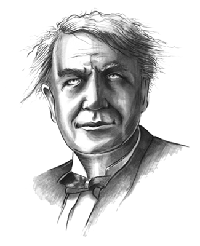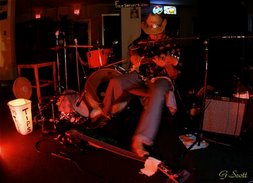
Edison's light bulbs employed a conducting filament mounted in a glass bulb from which the air was evacuated leaving a vacuum. Passing electricity through the filament caused it to heat up enough to become incandescent and radiate light, while the vacuum prevented the filament from oxidizing and burning up.
a
Edison continued to experiment with his light bulbs and, in 1883, found that he could detect electrons flowing through the vacuum from the lighted filament to a metal plate mounted inside the bulb. This discovery subsequently became known as the Edison Effect.
In 1875, American, G.R. Carey invented the phototube.
In 1878, Englishman Sir William Crookes invented the 'Crookes tube', an early prototype of cathode-ray tube.
In 1895, German, Wilhelm Roengten invented an early prototype Xray tube.
In 1897, German, Karl Ferdinand Braun invents the cathode ray tube oscilloscope.
In 1904, John Ambrose Fleming invented the first practical electron tube called the 'Fleming Valve'. Leming invents the vacuum tube diode.
In 1906, Lee de Forest invented the audion later called the triode, an improvement on the 'Fleming Valve' tube. Lee de Forest introduced a third electrode called the grid into the vacuum tube. The resulting triode could be used as both an amplifier and a switch.
These type of dudes don't usually get mentioned when people talk about electric blues but they are the ones that first made it possible.
It is a shame that Ben Franklin never got to play an electric guitar. I am sure he would been a real head-banger.
I don't really have a great understanding of how amplifers and tubes work. I am able to make repairs on my amps by looking at them and finding bad connections and re-soldering them. I gennerally have this problem with my Fender Blues Junior which is a relatively newer amp that I bought at Mars Music when they were going out of business. It is a 15 watt tubecombo with a 15" speaker. A "combo" is one where the amplifer section and the speaker cabinet are all in one unit. The problem with this little amp is that the solder connections don't seem to be as good as in the older amps. Basically, "They don't build em like they use to" .
Also, It is a pretty hot running amp for a 15 watt. As far as watts, Tube amplifers are generally more powereful or louder than solid state. This particular amp is set up with the power tubes (EL84's) are being pushed pretty hard and they run pretty hot. This will cause the tubes to wear out quicker. For a 15 watt amp, It can get pretty loud and is powerful enough to use at small to medium size clubs. The problem with a combo amp is that the vibration from the speaker (since it is in the same unit) can cause connections to rattle loose. The tubes also get vibrated and will be more sensitive to becoming "microphonic"
On the Blues Junior, I wonder if the heat from the power tubes causes the solder to fail or if it is just the poor design of the tube socket holder or just a cobonation of several factors including vibration from the speaker.
I have had to open up the back and re-solder the power tube connections several times and also one of the connections on the reverb tank.
I also do have a couple of older Fender amps and have not run into this problem. They also used metal in the input jacks instead of the plastic used on Blues Junior. Still, I do think the Blues Junior is a great amp particularly considering what they cost.
One of the things about tube amps is that when you get the tone you like, It is best to leave it alone until something breaks or wears out. You can replace the tubes with the exact same brand and not get the same sound. That is one thing that I like about the "Groove Tubes" which are tested and rated. You can buy a matched set with a numbered rating (from 1 to 10) and get pretty close to the same tone. The other advantage is that if you use the same number/rating, you don't have to have to have the amp re-biased (if it is not self biasing)
Tubes are only part of the equation when it comes to tone but they are a big part. Another big variable is the Guitar Pick-up not to mention the equipment operator.
You may be asking "What is your point Marc?"
& if so, I would like to ask you something:
What is the cross between an Elephant and a Rhino?
The answer is NOT "What is on second"

2 comments:
I bought a CD from you last month at the Velvet Melvin Club and really am glad to have it in my collection.
We were driving by and saw the "Live Blues" sign so we stopped. As I was walking in I heard a band playing but was shocked when I saw it was just one guy playing drums and two guitars at the same time. I play guitar as a hobby and love blues. I was very impressed with your selection of material and antics also. Very entertaining!
I have been out of the country but we are planning to see you again soon.
Best Wishes,
Jerry Galvane
Houston, Texas
Thanks Jerry,
I am glad that you did stop in.
I actually put the "Live Blues" signs out myself & the fact that you came in made it worth the effort.
Thanks for all the kind words and supporting live music.
Marc
Post a Comment